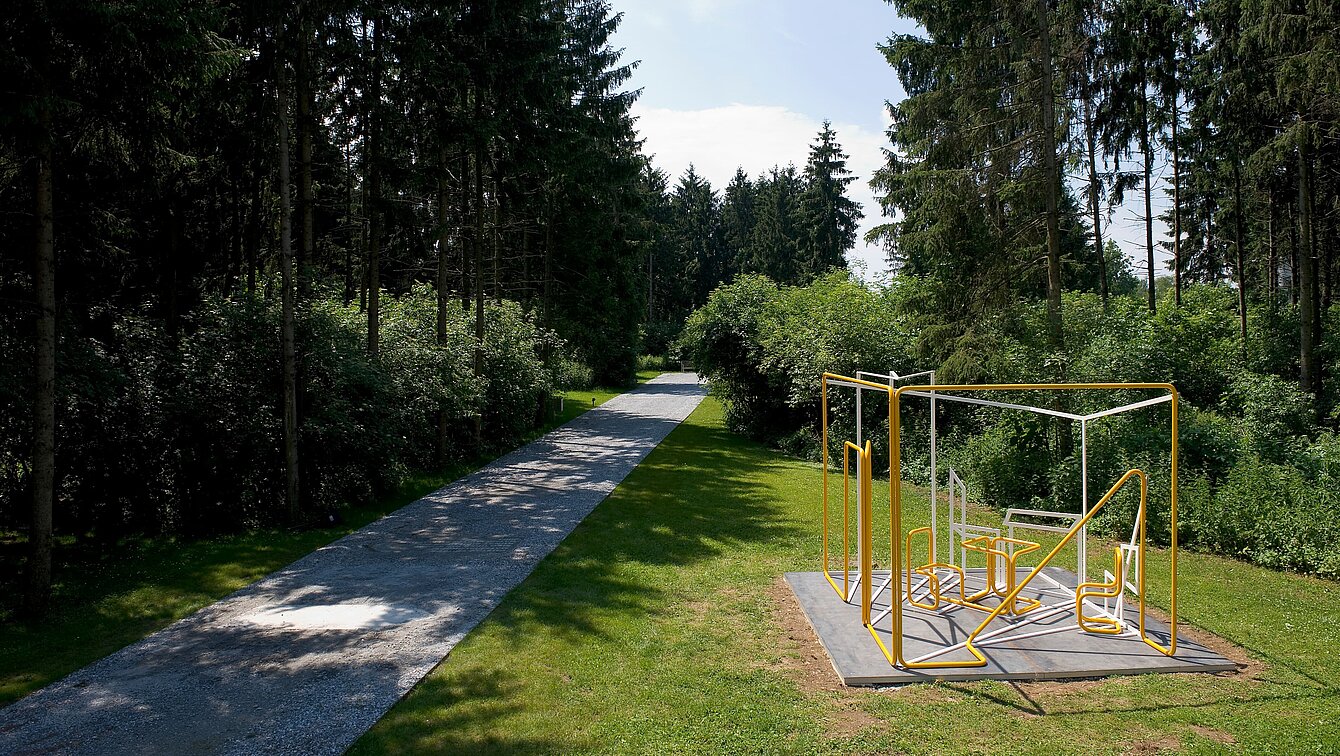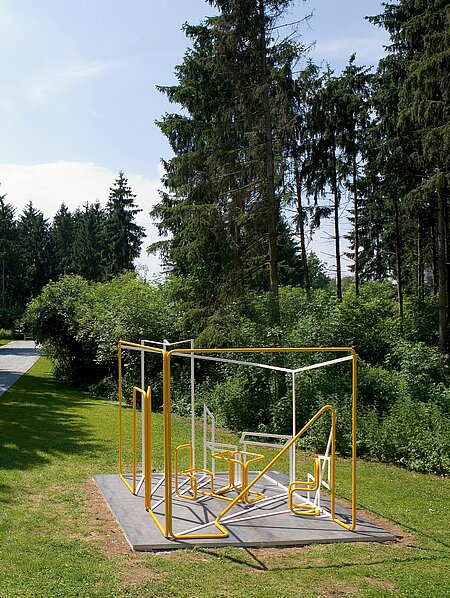The space between object and environment always plays a role in Uncini’s sculptures. The reality of an object is represented by orangepainted steel tubing. Additional space is indicated by the shadows, which are part of the sculptures in the form of grey metal rods hammered flat. The floor is made of corten steel and so changes gradually with the effects of the climate and weather. This illustrates Uncini’s interest in the independent transformation of materials and also integrates time as a factor into the work.
Unità Cellulare
Giuseppe Uncini, 1967/2008


Image Credits
Author
Elisabeth Fiedler und Peter Weibel
Location on map
Position 61
Owner
Universalmuseum Joanneum
Artist biography
Giuseppe Uncini
Show all
About the sculpture
Italian art of the 1950s is characterised by the most diverse forms of artistic expression, ranging from traditional realistic trends to abstract, not-object related concrete or informal formulation. Fiercely controversial debates between numerous groups of artists mark this period.
Giuseppe Uncini, born in 1929 in Fabriano, studied at the Istituto d`Arte in Urbino from 1947 until 1948 and came to Rome in 1953; a city which, back then – in addition to Milan – represented the most important centre of art in Italy that dealt with international trends and place where he meets leading representatives of Italian Art Informel. However, Uncini neither follows this movement nor does he see his intentions reflected in Minimal Art.
Thus, in 1962, together with Gastone Biggi, Nicola Carrino, Achille Pace and Pasquale Santoro he founded Gruppo Uno in Rome with the aim of overcoming Art Informel by means of geometric forms and object-related work concepts. The group’s focus is particularly on the relationship between art and science, whereas apart from using traditional material, they also experimented with visual effects. During the last years of their collaboration, the artists concentrated mainly on exploring the relationship between space and surroundings. Their last important show was at the Venice Biennial in 1966 before the group disbanded in 1977.
Uncini developed a completely individual and new work of art within the changeover from representation as a depiction of reality to an autonomy of colours and objects since constructivism and the gradual abandonment of the image from the 1960s. This abandonment took place due to the influence of Lucio Fontana but also due to action art and increased audience participation. Uncini – who always worked at the intersection between drawing, painting, sculpture and architecture – strove to liberate his work from material weight and genuine individuality.
By including scientific knowledge, the meaning of light, consideration of shadow and the discovery of emptiness as an element of sculpture or architecture, Uncini produces an awareness of the interplay between what is possible and what is not. Since science is not capable of regulating our capacity for perception, Uncini’s spaces can be defined both physically and conceptually.
In principle his aim is not to represent or convey ideas, but to create constructed works devoid of meaning outside their mere appearance and presence. By overcoming the limits of drawing, painting and sculpture he would use cement and iron rods for the first time in 1958. This material was not only common and uncomplicated, the material even continued to work for itself. Thus, with Cementi Armati, he created a three-dimensional sculpture, stemming from surface and structure.
Uncini was the first sculptor to treat the problem of the shadow as a sculptural problem. In his work shadow stands for a space, which both exists and does not exist; an illusory space, virtual space, which he can make visible only by materialisation. Inspired by this, Uncini understood that a sculpture not only covers space but also creates a new space between itself and the environment, an interspace that is also part of the sculpture. This interspace too is materialised in a sculptural way. All of this results in a sculpture consisting of both negative and positive volumes, of space and interspace, material and immateriality.
In 1967 Uncini took part in trigon 67 biennial in Graz. He installed a metal sculpture entitled Unità Cellulare outside the Künstlerhaus, which represents the contours of a furnished interior space and the shadow effects thereof. Drawn in one almost continuous line, the parts identified as real appear as orange-painted steel tubing, whilst the corresponding shadows are grey metal rods hammered flat.
The space assigned to man – correspondingly large – reaches a degree of permeability, which in addition to addressing the subject of public and private space, allows for following shadows, man’s natural, ever-changing companion. And, as we all learned from Romantic literature, without a shadow, man falls into melancholy and insanity.
This work highlights both the tangibility of the real and the imaginary between exact design and unalterable external appearance, and Uncini’s interest in an independent mutation of materials. Indeed, the floor is made of Corten steel, a material that continues to develop when subjected to weathering until it starts to rust to a certain degree, thereby integrating the temporal factor on a second level. Furthermore we are led into some sort of ambivalence between fullness and emptiness, presence and absence, of which we ourselves will become part.
The rule that preliminary drawings and sketches are essential parts of his work applies here too. They are part of the collection of Neue Galerie and by means of them and in correspondence with the artist it was possible to have the only authorised reconstruction as an important international position for Sculpture Park Austria.


















